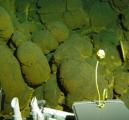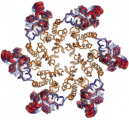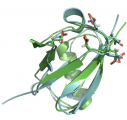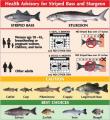The advent of photosynthesis gave life forms a new way to capture energy from the sun. The by-product of the success of photosynthesis, an abundance of dioxygen (O2) in our atmosphere allowed aerobic creatures, including humans, to evolve and prosper. This process transformed the history of life on Earth. The oxidation of water to O2 is catalyzed by the oxygen-evolving complex (Mn4OxCa cluster) in the membrane protein, photosystem II (PSII).
Approximately 1,700 scientists visit SSRL annually to conduct experiments in broad disciplines including life sciences, materials, environmental science, and accelerator physics. Science highlights featured here and in our monthly newsletter, Headlines, increase the visibility of user science as well as the important contribution of SSRL in facilitating basic and applied scientific research. Many of these scientific highlights have been included in reports to funding agencies and have been picked up by other media. Users are strongly encouraged to contact us when exciting results are about to be published. We can work with users and the SLAC Office of Communication to develop the story and to communicate user research findings to a much broader audience. Visit SSRL Publications for a list of the hundreds of SSRL-related scientific papers published annually. Contact us to add your most recent publications to this collection.
UC Irvine researchers have unveiled the mystery behind one of the deadliest toxins that causes liver cancer. Aflatoxins are common contaminants of foods such as nuts and grains, which make up the staple diets of many developing countries. These toxins are produced by moldy fungi during food production, and are considered by the FDA to be an unavoidable food contaminant. Aflatoxin molecules are characterized by the presence of multiple aromatic rings. Chronic ingestion of aflatoxin B1 leads to liver tumors that are a major cause of death in Asia, Africa, and Central America. This toxin wreaks havoc of p53, an important gene in our body that prevents cancer. Without the protective effect of p53, then, aflatoxin further compromises immunity, interferes with our body metabolism, and causes severe malnutrition. It is urgently important to find inexpensive strategies that help protect the world population from aflatoxin food contamination.
Copper is an essential ingredient for animal and plant life. Some proteins specifically bind copper for both structural and catalytic purposes. Up until now, mononuclear copper(II) ion binding sites fit into two categories, type 1 and type 2, defined by both their functional roles, structures, and the physical properties of the interactions.
New rock formed by deep undersea volcanoes does not stay bare long. Microbes quickly move onto these basalts to form communities in the form of biofilms. As these biofilms grow and develop, they change the geology of their environment, forming mineral deposits. Since many of these communities are deep in the cold ocean waters, where sunlight does not reach, they must use alternative sources of energy. What these might be is unknown, but a common theory posits that the microbes may be obtaining energy using materials from the rock itself.
The genome of the human immunodeficiency virus (HIV-1) is bundled inside a capsid composed of about 1,500 copies of the viral Capsid Assembly (CA) protein. These proteins first assemble into substructures, each with six proteins, and these substructures come together to create the cone-shape casing of the virus. Disruption of capsid formation is a natural target for HIV therapies, and knowing the atomic structure of the CA proteins in the capsid would be useful for drug development. However, inherent flexibility in these molecules makes obtaining quality crystals difficult.
Crystals of different sizes and shapes have different functional properties. This is certainly true in the case of platinum nanocrystals, which can be used to increase catalytic reactions including hydrogen cell fuel oxidation. Understanding crystallization processes will allow researchers to fine-tune the shape, size, and quality of crystals for specific, tailored applications.
DNA is a relatively stable molecule, but it can be damaged by chemicals generated inside our cells or by radiation originating from outside our cells. Significant amounts of DNA damage can lead to rapid-aging, cancer, and other diseases, so the cell has a fleet of enzymes that specialize in combating this daily wear-and-tear. One important group of DNA repair enzymes is the Rad60 family of proteins that is highly conserved from yeast to humans.
The information encoded in genes is only useful if the decoder is accurate. The complicated process of translating information from nucleic acid to proteins incorporates systems that ensure accuracy and systems that edit inaccuracies. The ribosome has mechanisms to make certain that the codon on the messenger RNA matches the aniticodon on the transfer RNA before it adds the amino acid to the growing polypeptide chain. But it is just as critical that the tRNA is properly charged with the amino acid dictated by the genetic code. The synthetases that are responsible for placing amino acids on tRNAs have an editing feature that double-checks the match.
High levels of mercury in our diets can have adverse effects on our health, and fish are a major source of dietary mercury. Because of a process called biomagnification, mercury levels in fish can build up to be at a much higher concentration than in the surrounding water. The mercury that accumulates in the tissue of fish is in the form of methylmercury, but this is not necessarily the chemical form that pollutes the water. Microorganisms living in the rhizosphere, or root zone, of plants are responsible for much of the methylation of mercury.
While the normal function of human prion protein (PrP) remains a mystery, the results of abnormal PrP are quite well known. Misfolded PrP (denoted PrPSc) leads to diseases such as Creutzfeldt-Jakob disease, mad cow disease, and scrapie in sheep. In these diseases, the protein acts like an infectious agent, recruiting other PrP to become PrPSc without requiring any involvement from nucleic acids or any other molecules. Many PrPSc molecules can bind together to form amyloid structures, similar to those that contribute to a wide variety of diseases including Alzheimer's and Parkinson's.













